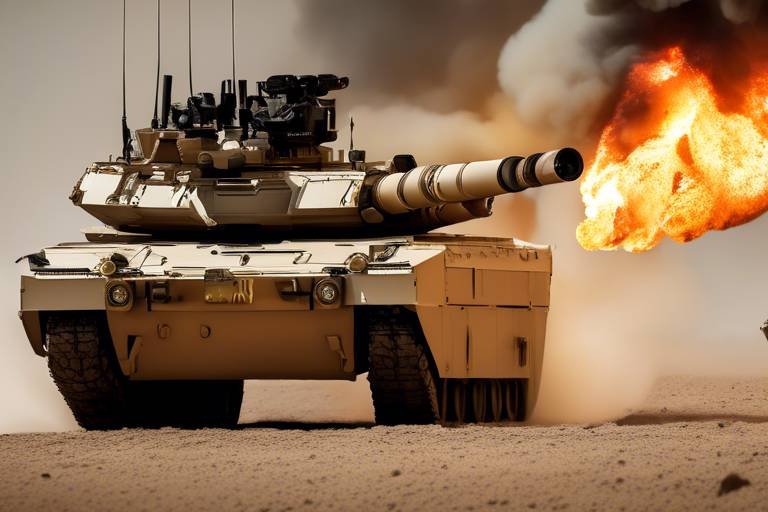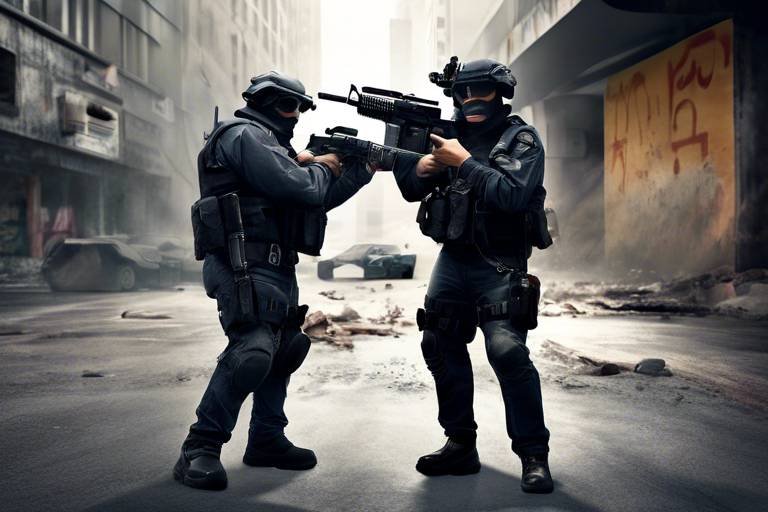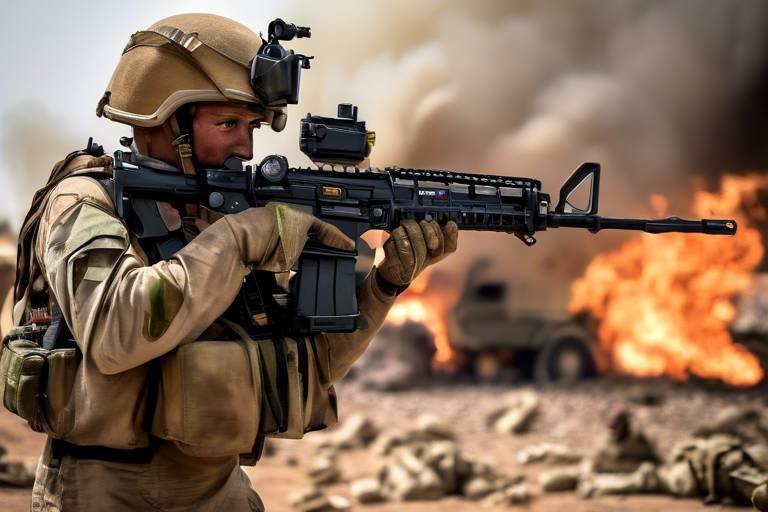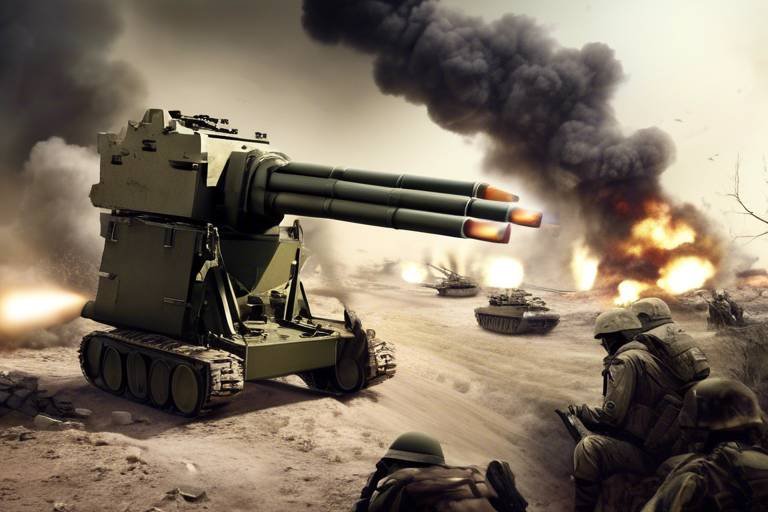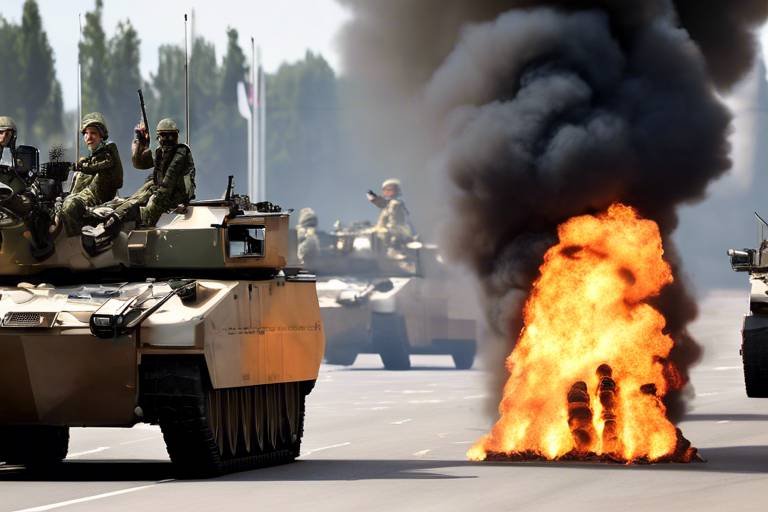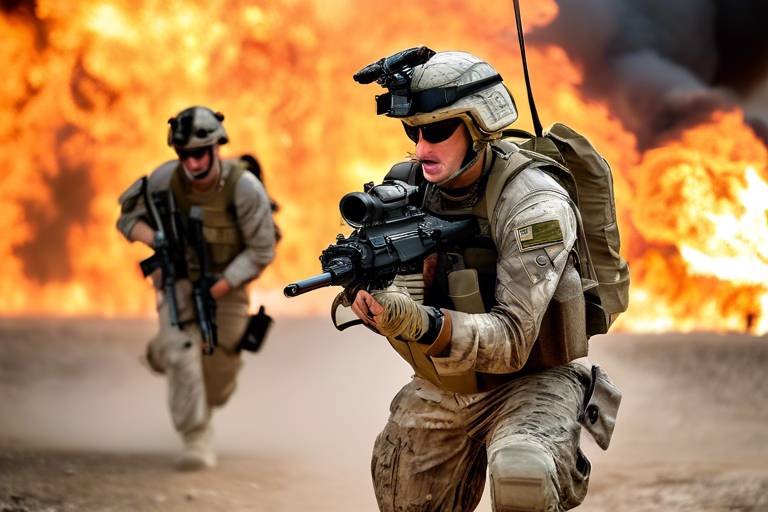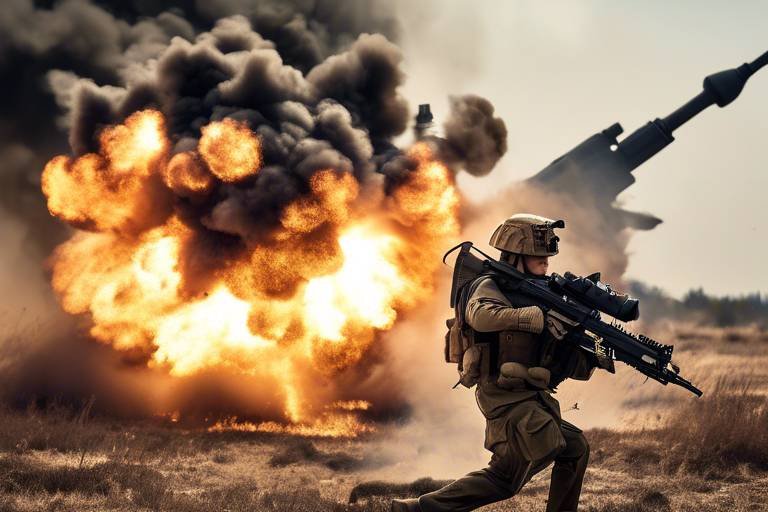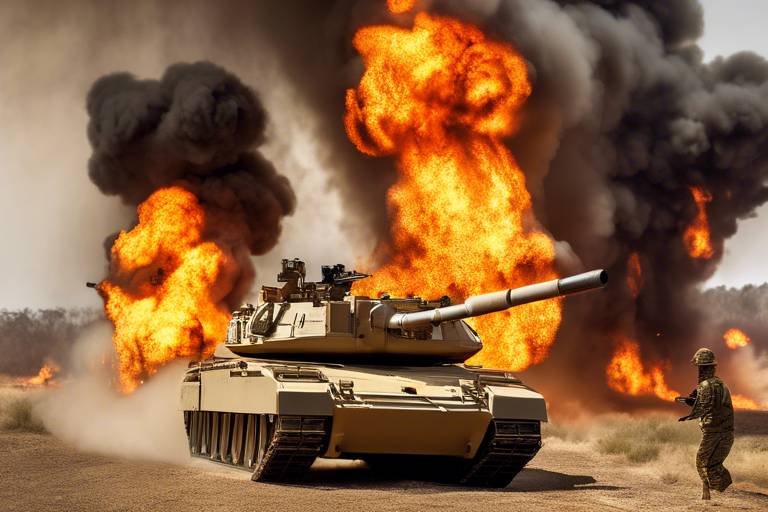How Firepower Shapes National Military Strategies
In the complex world of international relations and defense, the term firepower resonates with a weight that goes beyond mere weaponry. It is the backbone of national military strategies, shaping the way countries approach warfare, diplomacy, and global security. As we dive into this topic, we’ll explore how firepower has evolved over time, its various forms, and how it influences military strategies today. So, why does firepower matter so much? Imagine a chess game where each piece represents a different type of military force; the stronger your pieces, the more control you have over the board. In a similar vein, firepower gives nations the ability to project strength and deter adversaries.
Firepower has transformed dramatically from the days of ancient warfare to the modern battlefield. Early civilizations relied on simple tools like bows and arrows, which evolved into more sophisticated weaponry such as cannons and rifles. Each advancement brought about a shift in military tactics, forcing nations to rethink their strategies. For instance, the introduction of gunpowder in the 9th century revolutionized warfare, allowing armies to engage from greater distances and with more devastating effects. Fast forward to today, and we see technology like drones and precision-guided munitions redefining how conflicts are fought. The evolution of firepower is not just a timeline of weaponry; it’s a narrative of human ingenuity, adaptation, and the relentless pursuit of dominance.
To fully grasp the impact of firepower on military strategies, it's essential to categorize its various forms. Broadly speaking, firepower can be divided into three categories: conventional, nuclear, and asymmetric. Each type has its own strategic implications and plays a distinct role in shaping national defense policies. Conventional firepower, for instance, is what most people envision when they think of military strength—tanks, aircraft, and infantry units. Nuclear firepower, on the other hand, serves as a formidable deterrent against existential threats, while asymmetric firepower often comes into play in conflicts involving non-state actors. Understanding these categories helps clarify the complex landscape of modern warfare.
When we talk about conventional firepower, we refer to the standard weaponry utilized in traditional warfare scenarios. This includes everything from rifles to artillery and armored units. The impact of conventional firepower on battlefield dynamics is profound; it not only dictates the outcome of engagements but also influences national defense policies. For example, countries with robust conventional forces often feel more secure and are less likely to engage in aggressive posturing. In this context, the presence of powerful artillery and armored units can deter potential aggressors, creating a stable security environment.
Artillery and armored units form the backbone of conventional military forces. They provide the necessary firepower to support ground troops and can turn the tide of battle in an instant. Consider the role of tanks in World War II; their mobility and firepower allowed for rapid advances and breakthroughs in enemy lines. In modern warfare, advancements in technology have led to the development of more sophisticated artillery systems that can strike targets with pinpoint accuracy from considerable distances. This evolution enhances not only the effectiveness of military operations but also the strategic planning involved in national defense.
Air power has revolutionized military operations, offering strategic advantages that ground forces alone cannot achieve. The ability to conduct airstrikes, perform reconnaissance, and transport troops rapidly has become indispensable in contemporary conflicts. Nations with superior air power can dominate the battlefield, providing support to ground forces and disrupting enemy operations. The Gulf War is a prime example of how air superiority can dictate the pace and outcome of a conflict. In today's military strategies, air power is not just an asset; it is a critical component that shapes how wars are fought and won.
Nuclear firepower introduces a unique dimension to military strategy. It serves as a powerful deterrent, influencing international relations and shaping the balance of power among nations. The mere possession of nuclear weapons can alter a country's standing on the global stage, compelling adversaries to reconsider their actions. The doctrine of mutually assured destruction (MAD) underscores the chilling reality that nuclear firepower can prevent large-scale conflicts, as the consequences of a nuclear exchange would be catastrophic for all parties involved. Understanding nuclear firepower is essential for comprehending the complexities of modern military strategy and international diplomacy.
Asymmetric warfare presents significant challenges to traditional military strategies. In this context, non-state actors often leverage unconventional firepower to counter established military forces. These groups may not possess the same level of conventional firepower, but they employ tactics that exploit vulnerabilities in their opponents. This shift in the battlefield dynamic has forced nations to adapt their strategies and rethink how they approach security.
One of the most effective forms of asymmetric warfare is the use of guerrilla tactics. These tactics allow smaller, less-equipped forces to achieve strategic objectives by leveraging their knowledge of the terrain and the element of surprise. Historical examples abound, from the Viet Cong in Vietnam to modern insurgent groups in the Middle East. Guerrilla tactics can disrupt conventional forces, making them rethink their strategies and often leading to a protracted conflict.
In our increasingly digital world, cyber warfare has emerged as a new frontier of firepower. This form of warfare involves the use of technology to disrupt, damage, or gain unauthorized access to information systems. As nations become more reliant on technology, the implications for national security are profound. Cyber attacks can cripple infrastructure, steal sensitive information, and undermine public trust. The need for adaptation in modern warfare has never been more critical, as nations must now consider both physical and digital realms in their military strategies.
- What is firepower? Firepower refers to the capacity of a military force to deliver effective fire against an enemy. It encompasses various types of weaponry and tactics used in warfare.
- How has firepower evolved over time? Firepower has evolved from simple weapons like bows and arrows to advanced technologies such as drones and cyber warfare capabilities, significantly altering military strategies.
- What are the different types of firepower? The main types of firepower include conventional, nuclear, and asymmetric firepower, each with unique strategic implications.
- Why is nuclear firepower important? Nuclear firepower serves as a deterrent against existential threats and plays a crucial role in maintaining the balance of power among nations.
The Evolution of Firepower
Firepower has been a pivotal force in shaping military strategies throughout history, evolving dramatically from the days of primitive weaponry to the advanced technologies we see today. In ancient times, armies relied on close combat weapons like swords, spears, and bows. These tools were not just instruments of war; they were extensions of the soldiers' will and skill. As civilizations grew and conflicts intensified, the need for more effective means of warfare became apparent.
With the advent of gunpowder in the 9th century, the landscape of battlefields transformed. Cannons and firearms introduced a new dimension to warfare, allowing armies to engage enemies from greater distances. This shift marked the beginning of a new era where firepower became synonymous with military strength. The introduction of artillery changed not only how battles were fought but also how strategies were devised. Armies began to prioritize the development of tactics that maximized the use of these powerful weapons.
As we moved into the 19th and 20th centuries, technological advancements continued to redefine firepower. The Industrial Revolution brought about mass production of weapons, leading to the creation of more sophisticated armaments. The introduction of tanks during World War I and the use of aircraft in warfare during World War II showcased the importance of mobility and aerial dominance. These innovations fundamentally altered military strategies, emphasizing the need for combined arms operations where different types of firepower worked in concert.
In the latter half of the 20th century, the nuclear age emerged, introducing a form of firepower that had never been seen before. The destructive capability of nuclear weapons not only changed the nature of warfare but also influenced international relations. The concept of mutually assured destruction (MAD) became a cornerstone of military strategy for superpowers, highlighting the importance of firepower in maintaining global peace through deterrence.
Today, firepower continues to evolve with the integration of technology into military operations. The rise of precision-guided munitions, drones, and cyber capabilities has reshaped how nations approach warfare. Understanding the evolution of firepower is essential for analyzing current military strategies and anticipating future developments. As we look to the future, the question remains: how will emerging technologies further redefine the balance of power and the nature of conflict?
In summary, the evolution of firepower reflects a continuous quest for dominance on the battlefield. Each technological advancement has not only enhanced military capabilities but has also required a reevaluation of strategies and tactics. As nations adapt to these changes, the implications for global security and defense policies are profound and far-reaching.
Types of Firepower
When we talk about firepower, it’s essential to recognize that it comes in various forms, each with its own strategic implications. Understanding these types helps us grasp how military strategies are shaped and executed across the globe. Firepower can be broadly categorized into three main types: conventional, nuclear, and asymmetric. Each of these categories plays a crucial role in defining how nations approach warfare and defense. Let's dive deeper into these categories and see what makes each one unique.
Conventional firepower refers to the standard weaponry and tactics used in traditional warfare. This includes everything from infantry weapons to tanks and artillery. It's the backbone of most military forces and has a profound impact on battlefield dynamics. Nations invest heavily in conventional forces because they provide the ability to engage in direct confrontations with opposing armies. The effectiveness of conventional firepower can often be measured in terms of fire rate, range, and accuracy.
For instance, consider the role of artillery and armored units. These units are not just tools of destruction; they are strategic assets that can dominate the battlefield. Artillery provides long-range support, allowing for the suppression of enemy forces before ground troops even engage. Meanwhile, armored units, with their combination of mobility and firepower, can break through enemy lines, creating chaos and confusion. The following table illustrates the key characteristics of conventional firepower:
| Type of Firepower | Key Characteristics | Strategic Importance |
|---|---|---|
| Artillery | Long-range, high-impact | Suppresses enemy forces |
| Armored Units | Mobile, heavily armed | Breaks enemy lines |
| Infantry Weapons | Versatile, close combat | Holds ground and engages |
Another critical component of conventional firepower is air power. The introduction of aircraft into warfare has revolutionized military operations. Air power provides a strategic advantage that can change the course of conflicts. Think about it: having the ability to strike from above, gather intelligence, and provide support to ground troops can tip the scales in favor of a nation. The flexibility and speed of air units make them indispensable in modern military strategies.
Moreover, air power is not just about bombers and fighter jets; it also encompasses reconnaissance and surveillance capabilities. These elements ensure that military leaders have the information they need to make informed decisions. In today's interconnected world, the synergy between air and ground forces is more critical than ever.
Now, let’s pivot to a different kind of firepower: nuclear firepower. This form of firepower is unlike any other, serving primarily as a strategic deterrent rather than a conventional tool for warfare. The possession of nuclear weapons is often seen as a way to maintain a balance of power among nations. Countries with nuclear capabilities can deter aggression from adversaries, knowing that the consequences of a nuclear conflict would be catastrophic.
The implications of nuclear firepower extend beyond mere military strategy; they reshape international relations and influence global security policies. The threat of mutually assured destruction (MAD) creates a fragile peace, where nations must constantly navigate the complexities of diplomacy and defense.
As we explore the landscape of firepower, it's crucial to understand the challenges posed by asymmetric warfare. This form of conflict often involves non-state actors utilizing unconventional firepower to counter established military forces. In this context, traditional military strategies may falter, prompting nations to adapt and rethink their approaches to defense.
One notable example of asymmetric warfare is the use of guerrilla tactics. These tactics leverage limited firepower to achieve strategic objectives, often focusing on mobility and surprise rather than direct confrontation. Historical examples, such as the Viet Cong during the Vietnam War, illustrate how smaller forces can effectively challenge larger, more conventional armies by using the element of surprise and intimate knowledge of the terrain.
In recent years, cyber warfare has emerged as an innovative form of firepower. As nations become increasingly reliant on technology, the ability to conduct cyber attacks can disrupt military operations and national security. This new battleground requires adaptation and a reevaluation of traditional military strategies to address the growing significance of cyber capabilities in modern warfare.
- What is firepower? Firepower refers to the capacity of a military force to deliver effective fire on an enemy, using various weapons systems.
- How does air power influence military strategies? Air power provides strategic advantages such as rapid response, intelligence gathering, and support for ground operations.
- What are the implications of nuclear firepower? Nuclear firepower serves primarily as a deterrent, influencing international relations and global security dynamics.
- What is asymmetric warfare? Asymmetric warfare involves conflict between opposing forces that differ significantly in military power or tactics, often featuring unconventional methods.
Conventional Firepower
When we think about , it’s essential to recognize that it encompasses the standard weaponry and military capabilities used in traditional warfare. This includes everything from infantry weapons to tanks, artillery, and aircraft. The significance of conventional firepower can’t be overstated; it is the backbone of any nation’s defense strategy, shaping how conflicts are approached and resolved. Imagine a chess game where each piece represents a different type of weaponry—each has its own role, and the way they are deployed can determine victory or defeat.
Throughout history, conventional firepower has evolved dramatically. For example, during World War I, the introduction of machine guns and artillery changed the face of battlefields, leading to trench warfare that resulted in unprecedented casualties. Fast forward to today, and we see advanced technologies like precision-guided munitions and drones that allow for more strategic and less destructive engagements. This evolution not only impacts military tactics but also influences national defense policies as countries strive to keep pace with technological advancements.
One of the key elements of conventional firepower is the role of artillery and armored units. These forces are designed to deliver overwhelming firepower against enemy positions, providing crucial support to infantry operations. The effectiveness of artillery can be seen in its ability to bombard enemy fortifications, making way for ground troops to advance. Similarly, armored units, like tanks, serve as mobile fortresses on the battlefield, capable of delivering devastating fire while protecting their crews. Their presence often dictates the flow of battle, forcing opposing forces to adapt their strategies.
Moreover, we cannot overlook the impact of air power in conventional warfare. The ability to project power from the skies has revolutionized military operations. Air superiority allows forces to conduct operations with reduced risk, providing cover for ground troops and enabling swift strikes against enemy positions. The integration of air power into military strategies has led to a shift in how nations plan and execute their operations, making it a critical component of conventional firepower.
In summary, conventional firepower remains a vital aspect of military strategy, influencing everything from tactical decisions on the battlefield to broader national security policies. As nations continue to develop and refine their military capabilities, understanding the dynamics of conventional firepower will be crucial for predicting future conflicts and ensuring effective defense strategies.
- What is conventional firepower? Conventional firepower refers to the standard weaponry and military capabilities used in traditional warfare, including infantry weapons, artillery, and armored units.
- How has conventional firepower evolved over time? Conventional firepower has evolved from the use of basic weaponry in ancient times to advanced technologies like precision-guided munitions and drones in modern warfare.
- Why is air power important in conventional warfare? Air power is crucial as it provides strategic advantages, allowing for effective strikes against enemy positions and supporting ground operations.
- What role do artillery and armored units play? Artillery and armored units deliver significant firepower and support to ground troops, shaping the dynamics of battlefield engagements.
Artillery and Armored Units
When we think about the backbone of conventional military forces, artillery and armored units immediately come to mind. These elements have been pivotal in shaping the battlefield dynamics throughout history, evolving from simple catapults in ancient times to sophisticated tanks and long-range artillery systems today. The sheer power and versatility of these units can often dictate the outcome of conflicts, making them indispensable in any military strategy.
Artillery serves as the long-range fire support that can devastate enemy positions from a distance. Imagine being able to strike your opponent before they even see you coming—that's the beauty of artillery. Modern artillery systems, such as self-propelled howitzers and rocket artillery, are equipped with advanced targeting systems and precision-guided munitions, allowing them to hit targets with astonishing accuracy. This capability not only enhances the lethality of military operations but also plays a crucial role in force multiplication, enabling smaller units to exert greater influence on the battlefield.
On the other hand, armored units, primarily composed of tanks and armored fighting vehicles, provide the necessary mobility and protection on the ground. These units are designed to breach enemy lines, engage in direct combat, and support infantry operations. The presence of armored units can instill a sense of fear and urgency in opposing forces, often leading to a psychological edge in warfare. For instance, during World War II, the deployment of tanks like the German Panzer or the Soviet T-34 changed the face of ground combat, showcasing how armored units could dominate the battlefield.
Furthermore, the integration of artillery and armored units into a cohesive military strategy is essential. For example, a well-coordinated assault might involve artillery units softening up enemy defenses before armored units advance to exploit the breach. This synergy not only maximizes the effectiveness of each unit but also creates a formidable force that is difficult for adversaries to counter.
In contemporary military doctrine, the role of these units has expanded beyond traditional warfare. They are now often employed in peacekeeping missions and counter-insurgency operations, demonstrating their versatility. However, with the rise of asymmetric warfare, the challenge remains: how do conventional forces adapt to an environment where non-state actors utilize unconventional tactics? This is where the ongoing evolution of artillery and armored tactics comes into play, as militaries around the world continue to innovate and adjust to new threats.
In summary, artillery and armored units are not just relics of the past; they are dynamic components of modern military strategies. Their ability to deliver devastating firepower while maintaining mobility and protection makes them critical in both offensive and defensive operations. As we look to the future, the challenge will be to integrate these traditional forms of firepower with emerging technologies to ensure that they remain relevant in the ever-changing landscape of warfare.
- What is the primary role of artillery in modern warfare? Artillery provides long-range fire support to engage enemy positions and assist ground forces.
- How have armored units evolved over time? Armored units have transitioned from basic tanks to advanced vehicles equipped with sophisticated technology for better combat effectiveness.
- What is the significance of integrating artillery and armored units? Integration enhances operational effectiveness, allowing for coordinated assaults that maximize the strengths of each unit.
- How do non-state actors impact the use of conventional firepower? Non-state actors often employ unconventional tactics, forcing conventional forces to adapt their strategies to counter these threats.
Air Power
Air power has dramatically transformed the landscape of warfare, acting as a game changer in military operations since its inception. Imagine the battlefield of the past—soldiers clashing on the ground, their fates resting solely on the strength of their numbers and the might of their artillery. Now, picture the same scenario but with the added dimension of the sky. The ability to strike from above not only shifts the balance of power but also introduces a new layer of strategy that has become essential in modern military doctrine.
One of the most significant aspects of air power is its ability to provide rapid response and strategic reconnaissance. In a world where time is of the essence, the capability to deploy aircraft quickly can mean the difference between victory and defeat. Aircraft can deliver precision strikes on enemy positions, gather intelligence, and support ground troops, all while remaining out of reach of many traditional ground-based threats. This versatility makes air power an indispensable asset for any nation’s military strategy.
Moreover, air power plays a crucial role in establishing air superiority, which is the dominant position of one force over another in the air. Achieving air superiority allows a nation to control the airspace above the battlefield, providing freedom of movement for its own forces while restricting the enemy's capabilities. This control can be illustrated in a table showing the correlation between air superiority and operational success:
| Aspect | With Air Superiority | Without Air Superiority |
|---|---|---|
| Ground Operations | Enhanced mobility and protection | Increased vulnerability and risk |
| Logistics | Efficient supply lines | Disrupted supply and reinforcements |
| Intelligence Gathering | Real-time data and surveillance | Limited visibility and delayed information |
In addition to conventional air power, the advent of unmanned aerial vehicles (UAVs), commonly known as drones, has further revolutionized military strategies. Drones offer unique advantages, including the ability to conduct surveillance and precision strikes without risking human lives. This capability has allowed militaries to engage in operations that would have been too dangerous or politically sensitive for manned aircraft. As we delve deeper into the 21st century, the integration of advanced technologies, such as artificial intelligence and enhanced targeting systems, is only set to expand the role of air power in military strategy.
However, it's also important to recognize the challenges that come with reliance on air power. The cost of maintaining a modern air force can be astronomical, and nations must weigh the benefits against the potential for over-reliance on aerial capabilities. Additionally, the rise of anti-aircraft technologies and cyber threats poses significant challenges to air superiority, necessitating continuous adaptation and innovation within military strategies.
In conclusion, air power is not just a tool of warfare; it is a vital component that shapes national military strategies and impacts global security dynamics. As technology continues to evolve, the role of air power will undoubtedly expand, making it imperative for nations to stay ahead of the curve in this ever-changing arena.
- What is air power? Air power refers to the use of military aircraft and other flying vehicles to conduct operations in warfare, including air strikes, reconnaissance, and support for ground forces.
- Why is air superiority important? Air superiority is crucial because it allows a military to control the airspace, providing protection and operational freedom for its forces while limiting the enemy's capabilities.
- How have drones changed military strategy? Drones have revolutionized military strategy by allowing for surveillance and precision strikes without risking pilot lives, enabling operations that are more flexible and less politically sensitive.
Nuclear Firepower
Nuclear firepower is not just another category of military might; it is a game-changer in the realm of international relations and military strategies. Imagine a chess game where one player holds the ability to eliminate the entire board with a single move. That's the essence of nuclear capability. The sheer destructive power of nuclear weapons has forced nations to rethink their defense policies and diplomatic strategies. The existence of these weapons creates a delicate balance of power, often referred to as Mutually Assured Destruction (MAD), which can deter aggression but also escalate tensions.
Throughout history, the introduction of nuclear weapons has shifted the focus from traditional warfare tactics to a more strategic outlook. The Cold War era is a prime example, where the stockpiling of nuclear arsenals by superpowers led to a tense standoff that avoided direct conflict. Countries invested heavily in their nuclear capabilities, not just for defense but as a bargaining chip in international diplomacy. This arms race has resulted in a unique situation where a single miscalculation could lead to catastrophic consequences.
To better understand the implications of nuclear firepower, consider the following key points:
- Deterrence: The primary function of nuclear weapons is to deter adversaries from launching an attack. The thought of a devastating nuclear retaliation often keeps potential aggressors at bay.
- Global Security Challenges: The proliferation of nuclear weapons raises significant global security concerns. As more nations pursue nuclear capabilities, the risk of conflict increases, as does the potential for nuclear terrorism.
- Strategic Alliances: Nuclear capabilities often shape international alliances. Countries with nuclear weapons tend to form partnerships with those that share similar security interests, creating a complex web of alliances and rivalries.
Moreover, the ethical implications surrounding nuclear firepower cannot be overlooked. The decision to use such weapons involves weighing the potential for massive civilian casualties against strategic military objectives. This moral dilemma complicates the discourse on nuclear armament and disarmament, making it a contentious issue in global politics.
As we move further into the 21st century, the landscape of nuclear firepower continues to evolve. New technologies, such as hypersonic weapons and advancements in missile defense systems, are changing how nations perceive their nuclear arsenals. The emergence of these technologies raises questions about the future of nuclear deterrence and the potential for arms control agreements.
In conclusion, nuclear firepower remains a pivotal element in shaping military strategies and international relations. Its profound implications on global security necessitate a cautious approach, as nations navigate the fine line between maintaining peace and preparing for potential conflict. The ongoing dialogue about nuclear disarmament and non-proliferation is essential for fostering a safer world, where the destructive power of nuclear weapons does not dictate the terms of engagement.
- What is nuclear firepower? Nuclear firepower refers to the military capability of a nation to deploy nuclear weapons, which have the potential to cause mass destruction.
- How does nuclear firepower affect global security? It creates a deterrent effect that can prevent wars, but it also raises the stakes for conflict and increases the risk of nuclear terrorism.
- What is the concept of Mutually Assured Destruction? It is a doctrine where two or more opposing sides possess nuclear weapons, ensuring that any attack would lead to total annihilation of both the attacker and the defender.
- Are there efforts to reduce nuclear arsenals? Yes, various international treaties and agreements aim to promote nuclear disarmament and prevent the spread of nuclear weapons.
Asymmetric Warfare and Firepower
Asymmetric warfare has emerged as a defining characteristic of modern conflict, challenging traditional military strategies and forcing nations to rethink their approaches to firepower. Unlike conventional warfare, where two state actors confront each other with similar capabilities, asymmetric warfare often sees a powerful military force pitted against a weaker opponent that employs unconventional tactics. This dynamic creates a unique battlefield where the balance of firepower is not just about the quantity of weapons, but also about the effectiveness and creativity in their use.
The essence of asymmetric warfare lies in the ability of non-state actors, such as insurgent groups or terrorist organizations, to exploit the vulnerabilities of their adversaries. These groups often rely on guerrilla tactics, ambushes, and hit-and-run strategies that can be incredibly effective against larger, more technologically advanced forces. For instance, the use of improvised explosive devices (IEDs) has become a hallmark of asymmetric conflict, allowing smaller forces to inflict significant damage without the need for conventional firepower.
Moreover, the rise of technology has further complicated the landscape of asymmetric warfare. Cyber warfare, for example, has introduced a new dimension of firepower that transcends traditional military capabilities. Non-state actors can now conduct cyber attacks that disrupt critical infrastructure, steal sensitive information, and undermine public confidence in governmental institutions. This form of firepower is not limited by geography or physical resources, making it a potent tool in the arsenal of asymmetric combatants.
To illustrate the impact of asymmetric warfare on global security, consider the following table that outlines key characteristics and examples:
| Characteristic | Example |
|---|---|
| Guerrilla Tactics | Vietnam War - Viet Cong's use of ambushes |
| IEDs | Insurgency in Iraq - Use of roadside bombs |
| Cyber Attacks | Stuxnet - Attack on Iranian nuclear facilities |
| Propaganda | ISIS - Use of social media for recruitment |
As nations grapple with these challenges, it's essential to understand that firepower in asymmetric warfare is not merely about having the latest weapons technology. It's about adaptability, intelligence, and the ability to leverage limited resources for maximum impact. The effectiveness of asymmetric tactics often lies in their unpredictability, which can leave conventional forces struggling to respond effectively.
In conclusion, the interplay between asymmetric warfare and firepower has significant implications for national security strategies worldwide. As conflicts evolve, military leaders must recognize that traditional metrics of firepower are no longer sufficient. Instead, a comprehensive understanding of the diverse forms of firepower, including unconventional tactics and cyber capabilities, will be crucial in shaping future military strategies.
- What is asymmetric warfare? Asymmetric warfare refers to conflicts where opposing forces differ significantly in military power and tactics, often involving unconventional methods by the weaker side to exploit the vulnerabilities of the stronger opponent.
- How has technology influenced asymmetric warfare? Technology has enabled non-state actors to employ tactics like cyber warfare, allowing them to disrupt critical infrastructure and conduct operations without traditional military resources.
- What are some examples of asymmetric tactics? Examples include guerrilla warfare, the use of improvised explosive devices (IEDs), and cyber attacks, all aimed at leveraging limited resources for maximum effect.
Guerrilla Tactics
When we think about traditional warfare, images of grand armies clashing on open fields often come to mind. However, in the shadows of these conventional battles lies a different kind of warfare: . These strategies are not about overwhelming force; instead, they focus on mobility, surprise, and cunning. Guerrilla fighters often operate in smaller, decentralized units, utilizing their intimate knowledge of the terrain to launch swift attacks against larger, less agile forces. But what makes these tactics so effective?
At its core, guerrilla warfare is about leveraging limited resources to achieve maximum impact. Think of it as David versus Goliath, where the smaller force uses its agility and knowledge of the environment to outsmart a larger opponent. This approach can lead to significant victories even when the odds seem stacked against them. For instance, during the Vietnam War, the Viet Cong employed guerrilla tactics to great effect, using the dense jungles of Vietnam as a backdrop for ambushes and surprise attacks. Their ability to blend into the environment made it challenging for conventional forces to engage them effectively.
One of the key elements of successful guerrilla tactics is the element of surprise. Guerrilla fighters often strike swiftly and then vanish before the enemy can mount a counterattack. This unpredictability can create a psychological edge, instilling fear and uncertainty in the enemy ranks. Additionally, guerrilla warfare often involves hit-and-run attacks, where fighters target supply lines, communication centers, and other critical infrastructure, thereby disrupting the enemy's operations without engaging in head-to-head combat.
Moreover, guerrilla tactics are not limited to physical confrontations. In the modern context, they have evolved to include various forms of warfare, such as cyber attacks and information warfare. Non-state actors often utilize technology to spread propaganda, manipulate public perception, and even disrupt critical systems. This shift highlights the adaptability of guerrilla tactics in the face of changing warfare landscapes.
To illustrate the effectiveness of guerrilla tactics, consider the following table that outlines some historical examples:
| Conflict | Guerrilla Group | Key Tactics Used |
|---|---|---|
| Vietnam War | Viet Cong | Ambushes, booby traps, and tunnel systems |
| American Revolutionary War | Colonial Militias | Hit-and-run tactics, sabotage, and surprise attacks |
| Afghanistan War | Taliban | IEDs, ambushes, and leveraging local support |
In conclusion, guerrilla tactics represent a profound shift in how we understand military strategy. They remind us that sometimes, the smallest forces can create the largest impacts. As nations continue to grapple with the complexities of modern warfare, the lessons learned from guerrilla tactics will undoubtedly influence future military strategies.
- What are guerrilla tactics? Guerrilla tactics are unconventional warfare strategies used by smaller, mobile forces to conduct surprise attacks against larger, more traditional military units.
- How do guerrilla tactics differ from conventional warfare? Unlike conventional warfare that relies on large armies and direct confrontations, guerrilla tactics emphasize mobility, surprise, and the element of unpredictability.
- Can guerrilla tactics be used in modern warfare? Yes, guerrilla tactics have evolved to include cyber warfare and information manipulation, making them relevant in today's conflict scenarios.
Cyber Warfare
In today's digital age, has emerged as a formidable force that reshapes the landscape of national security and military strategy. Unlike traditional forms of warfare that rely on physical might, cyber warfare involves the use of digital attacks to disrupt, damage, or gain unauthorized access to computer systems and networks. The implications of this form of firepower are profound, as nations grapple with the challenges posed by non-state actors and state-sponsored hackers alike. Imagine a battlefield where the front lines are invisible, and the weapons are lines of code—this is the reality of modern conflict.
The rise of the internet and advanced technology has made it easier for adversaries to launch attacks without the need for conventional military engagements. From data breaches to ransomware attacks, the arsenal of cyber weapons available to malicious actors is vast. Countries like the United States, Russia, and China have recognized the significance of cyber capabilities, investing heavily in their cyber defense and offense strategies. The Stuxnet worm, for example, is a well-known case where cyber warfare was used to sabotage Iran's nuclear program, demonstrating that the digital realm can indeed be a theater of war.
As cyber warfare continues to evolve, the need for robust cybersecurity measures becomes paramount. Governments are now focusing on developing comprehensive strategies that encompass not only defense mechanisms but also offensive capabilities. This dual approach aims to deter potential aggressors by showcasing a nation's ability to retaliate in the cyber domain. However, the complexity of cyber warfare presents unique challenges, such as the difficulty in attributing attacks to specific actors, which can lead to escalations based on misinterpretations.
To better understand the significance of cyber warfare, we can categorize its impacts into several key areas:
- National Security: Cyber attacks can undermine critical infrastructure, such as power grids and financial systems, posing a direct threat to national stability.
- Economic Warfare: Disrupting business operations through cyber means can have devastating effects on a nation's economy.
- Information Warfare: Misinformation campaigns can sway public opinion and influence political landscapes, making information control a vital aspect of modern warfare.
As we look to the future, it’s clear that cyber warfare will play an integral role in military strategies worldwide. Nations must adapt to this new reality, recognizing that the next war may not be fought with tanks and planes but rather with algorithms and firewalls. The battlefield of the future will be defined by those who can navigate the complexities of the digital domain, making cyber warfare not just a component of military strategy but a cornerstone of national defense.
- What is cyber warfare? Cyber warfare refers to the use of digital attacks to disrupt, damage, or gain unauthorized access to computer systems and networks, often used by nations or groups to achieve strategic objectives.
- How does cyber warfare differ from traditional warfare? Unlike traditional warfare, which relies on physical forces and weapons, cyber warfare operates in the digital realm, utilizing code and technology to achieve military aims.
- What are some examples of cyber warfare? Notable examples include the Stuxnet attack on Iran's nuclear facilities and various ransomware attacks targeting critical infrastructure.
- Why is cybersecurity important in the context of cyber warfare? Robust cybersecurity measures are essential to protect national interests, prevent data breaches, and ensure the integrity of critical systems against potential cyber attacks.
Frequently Asked Questions
- What is firepower in military strategy?
Firepower refers to the capacity of a military force to deliver effective strikes against enemy targets. It encompasses a range of weapon systems and technologies, influencing how nations develop their military strategies and engage in warfare.
- How has firepower evolved over time?
Firepower has significantly transformed from ancient weaponry like bows and arrows to modern technologies such as drones and cyber warfare. Each evolution has reshaped military tactics and strategies, reflecting advancements in technology and changes in warfare dynamics.
- What are the different types of firepower?
Firepower can be categorized into several types, including conventional firepower, nuclear firepower, and asymmetric firepower. Each type has its strategic implications and plays a unique role in national defense and military operations.
- What role does conventional firepower play in military strategy?
Conventional firepower includes standard weaponry used in traditional warfare, such as artillery and armored units. It is crucial for establishing battlefield dominance and shaping national defense policies, providing a foundation for military capabilities.
- How does air power influence military operations?
Air power has revolutionized military operations by offering strategic advantages such as reconnaissance, rapid troop movement, and precision strikes. Its ability to control the skies can determine the outcome of conflicts and is a vital component of modern military strategies.
- What is the significance of nuclear firepower?
Nuclear firepower serves as a strategic deterrent in international relations. The possession of nuclear weapons can influence power dynamics between nations, often leading to a balance of power that shapes military strategies and defense policies globally.
- What challenges does asymmetric warfare pose?
Asymmetric warfare challenges traditional military strategies by employing unconventional tactics, often used by non-state actors. This form of warfare leverages limited firepower to achieve strategic objectives, complicating responses from established military forces.
- How effective are guerrilla tactics in warfare?
Guerrilla tactics can be highly effective, allowing smaller forces to take on larger, more conventional militaries. By using surprise, mobility, and knowledge of the terrain, guerrilla fighters can achieve significant strategic victories despite their limited firepower.
- What role does cyber warfare play in modern military strategy?
Cyber warfare is an emerging form of firepower that targets information systems and infrastructure. Its growing importance in national security highlights the need for military strategies to adapt to the digital age, where battles can be fought in cyberspace as much as on traditional battlefields.


